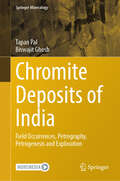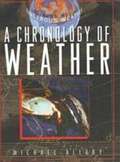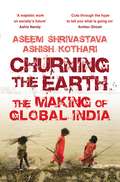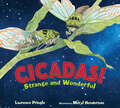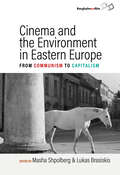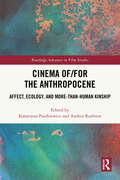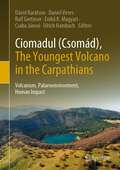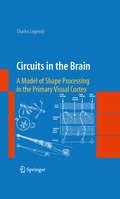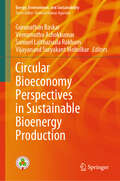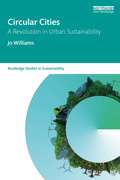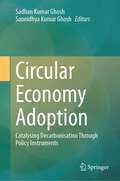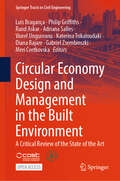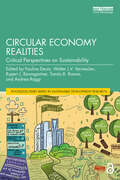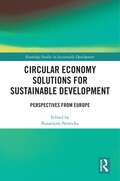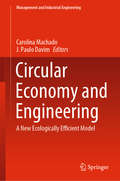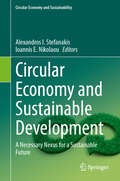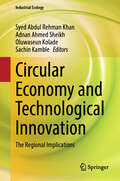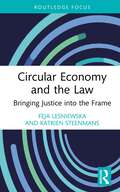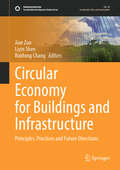- Table View
- List View
Chromite Deposits of India: Field Occurrences, Petrography, Petrogenesis and Exploration (Springer Mineralogy)
by Biswajit Ghosh Tapan PalThis book aims to provide an up-to-date and comprehensive account of field occurrences, stratigraphy, petrographic features, mineral chemistry, bulk chemistry and other physicochemical factors to assess the nature and origin of the chromitites of India. This book describes key features of important chromitite fields of the world. This book deals mainly compilation of data related to field occurrences, geological maps, stratigraphic and structural relations, litho-association, hand specimen details, field sketches, petrography (both in transmitted light and in reflected light), modal analyses and bulk chemistry. It also includes data on published and newly generated data on mineral chemistry, BSE images of EPMA/ SEM study and different mineral–geochemical discriminate plots for petrogenetic evolution. It incorporates data both on P, T of crystallization and re-equilibration conditions, data to assess the parental melt and source rock characterization. It also includes published data on 57FeMossbauer spectroscopic data to assess oxidation condition. Correlation of Indian chromitites with world deposit is done through comparative diagrams. Limited field study and laboratory data are generated to fill the gap of the available data. The comprehensive database of Indian chromitite helps to solve the intriguing problems on petrogenesis of chromitite of layered complex and podiform chromitite of ophiolite. This publication also has a scope to describe economic minerals associated with chromitite. Considering its economic use in industry, exploration activities of Indian chromitites are described. The database and their interpretation also help the explorer for future guide. Finally, global correlation of Indian field is attempted to give a comprehensive idea on chromitite field of India. This book being a rare encompassing all the aspects of chromitite attracts academician, students, researchers and explorers of India and abroad as well.
Chromium in Plants and Environment (Environmental Science and Engineering)
by Nitish Kumar Dharmendra K. Gupta Clemens WaltherThis edited book brings together a diverse group of environmental science, sustainability, and health researchers to address the challenges posed by global mass poisoning caused by chromium contamination of soil and plants. In recent years, contamination of the environment by chromium has become a major concern. Chromium is a non-degradable, harmful, and toxic pollutant which negatively affects the environment. It is unique among the heavy metals found in industrial wastewater and sewage and sludge, as it may exist as a trivalent cation and as anion in the hexavalent state in the pH range of agricultural soils. It is used on a large scale in many different industries, including metallurgy, electroplating, production of paints and pigments, tanning, wood preservation, chemical production, and pulp and paper production. These industries are contributing larger amount of chromium, which can ultimately have significant adverse effects on biological and ecological activities of ecosystem. Chromium enters the food chain through consumption of plant material. A high concentration of chromium has been found to be harmful to vegetation. As the chromium concentration in plants increases, it adversely affects several biological parameters and eventually renders the soil barren.The book sheds light on this global environmental issue and proposes solutions to contamination through multi-disciplinary approaches and case studies from different parts of the world.This book is a valuable resource to students, academicians, researchers, and environmental professionals who are doing field work on chromium contamination throughout the world.
Chronology of Weather (Dangerous Weather)
by Michael AllabyFrom the Book Jacket: A Chronology of Weather presents an overview of the dangerous weather described in preceding volumes in the series. It includes a time line of catastrophic weather events from c. 3,200 B.C. to 1997, as well as a chronology of meteorological discovery-comprising the lives and inventions of great weather scientists-from c. 340 B.c. to 1995. A Chronology of Weather also contains weather experiments that students can perform at home using ordinary household supplies, a glossary of meteorological terms, charts for wind measurement and cloud classification, and further readings suggested by the author. The Dangerous Weather series imparts fundamental weather science to readers through author Michael Allaby's vivid descriptions of extreme weather systems. The series focuses on the five most dangerous kinds of weather activity; diagrams related meteorological, climatological, and environmental basics in clear, compelling language; chronicles the history of each form of dangerous weather; and offers safety precautions for extreme weather conditions. Fully illustrated and indexed, the Dangerous Weather series is an invaluable tool for student research. Other volumes include: hurricanes tornadoes droughts blizzards floods Other books in this series are also available from Bookshare.
Churning the Earth: The Making of Global India
by Aseem ShrivastavaThe world stands so dazzled by India's meteoric economic rise that we hesitate to acknowledge its consequences to the people and the environment. In Churning the Earth, Aseem Shrivastava and Ashish Kothari engage in a timely enquiry of this impressive growth story. They present incontrovertible evidence on how the nature of this recent growth has been predatory and question its sustainability. Unfettered development has damaged the ecological basis that makes life possible for hundreds of millions resulting in conflicts over water, land, and natural resources, and increasing the chasm between the rich and the poor, threatening the future of India as a civilization.
Cicadas!: Strange and Wonderful (Strange and Wonderful)
by Laurence Pringle"Definitely the best cicada book for kids. Adults will appreciate it as well, as it is well written, factually accurate, and beautifully illustrated." —Cicadamania.com Discover why cicadas are all the buzz in the most complete, comprehensive book for kids about these noisy but harmless insects.Every year, annual cicadas emerge and pierce the air with their buzzing calls. Also every year, at least one brood of 13 or 17 year cicadas emerges in some part of the eastern or central United States. In Spring 2021, a group of 17 year periodical cicadas called Brood X will make their appearance in the Mid-Atlantic region of the United States. Author Laurence Pringle and illustrator Meryl Henderson have created the story of this fascinating and often misunderstood insect, one that deserves to be protected.
Cinema and the Environment in Eastern Europe: From Communism to Capitalism
by Masha Shpolberg and Lukas BrasiskisThe annexation of Eastern Europe to the Soviet sphere after World War II dramatically reshaped popular understandings of the natural environment. With an eco-critical approach, Cinema and the Environment in Eastern Europe breaks new ground in documenting how filmmakers increasingly saw cinema as a tool to critique the social and environmental damage of large-scale projects from socialist regimes and newly forming capitalist presences. New and established scholars with backgrounds across Europe, the United States, and Australia come together to reflect on how the cultural sphere has, and can still, play a role in redefining our relationship to nature.
Cinema of/for the Anthropocene: Affect, Ecology, and More-Than-Human Kinship (Routledge Advances in Film Studies)
by Andrea Ruthven Katarzyna PaszkiewiczCinema of/for the Anthropocene sheds new light on the question of how films can allow us to resituate ourselves within what is known today as the Anthropocene. The authors address this question through a variety of disciplines and theoretical perspectives, from film and cultural studies, new materialisms, critical posthumanism and animal studies, critical race theory and Indigenous media studies, to gender and sexuality studies, with a primary focus on films produced in the United States and Canada.The volume moves beyond the mere acknowledgment of the devastating damage inflicted during the Anthropocene to think about new ways of inhabiting the world through concepts such as affect, response-ability, and more-than-human kinship. The writers in this collection respond to its invitation by addressing a range of genres and modes, thus complicating the apocalyptic discourses which have typically been central to the studies on the Anthropocene: in addition to dystopian films, the volume discusses animated films, Hollywood biopics, climate change documentaries, experimental film, comedy, horror sci-fi, as well as disease thriller and survival film. Taken together, the chapters offer cross-disciplinary readings of the cinema of/for the Anthropocene, showing ways in which it can help us re-orient our thinking to make sense of the current age and address the planetary-scale environmental catastrophe.This volume will appeal to researchers and students in film studies, cultural studies, and the burgeoning field of environmental humanities.
Cinematic Cartography: Scale, Analysis, Topography (Routledge Spatial Humanities Series)
by Chris LukinbealThis book uniquely bridges the conceptual gap between the history of geographic, cartographic thought, and film theory with the technological and cultural shifts that shaped the emergence of cameras and cinema.Adorned with illustrative figures, examples, and case studies throughout, the book explores how cinema lends itself to cartography and, in turn, how cartography relates to both the individual and collective experience of cinema. By using cartography to understand space and scale in film, the book moves away from textual analysis or representation analysis to focus on the locational attribution of the sites where the cinematic landscape is being produced. It contends that viewers of moving images are active players in a complex network of cultural and mental geographies.This volume is essential reading for students, scholars, and academics of cinematography, human, cultural, and social geography, cartography, and media studies, as well as those interested in these areas more generally.
Ciomadul (Csomád), The Youngest Volcano in the Carpathians: Volcanism, Palaeoenvironment, Human Impact
by Dávid Karátson Daniel Veres Ralf Gertisser Enikő K. Magyari Csaba Jánosi Ulrich HambachThis book delivers the present state-of-the-art of scientific characteristics of the unique Ciomadul volcano (Romania, East-Central Europe) from as many aspects as possible.. Multidisciplinary research results obtained on this geologically young volcanic complex are presented to a wider audience (geologists, volcanologists, botanists, archaeologists, historians and teachers). Moreover, the book provides information at a general level for interested laypersons and decision-makers. The first part of the book, after summarizing the research history of Ciomadul, presents the details of the volcanism and related topics (volcanology, geology, landscape evolution, minerals, post-volcanic activity and spa culture) in eight chapters; the second part deals with the palaeo-environmental issues of the larger area, along with human history, in nine chapters.
Circuits in the Brain: A Model of Shape Processing in the Primary Visual Cortex
by Charles LegéndyDr. Charles Legéndy's Circuits in the Brain: A Model of Shape Processing in the Primary Visual Cortex is published at a time marked by unprecedented advances in experimental brain research which are, however, not matched by similar advances in theoretical insight. For this reason, the timing is ideal for the appearance of Dr. Legéndy's book, which undertakes to derive certain global features of the brain directly from the neurons. Circuits in the Brain, with its "relational firing" model of shape processing, includes a step-by-step development of a set of multi-neuronal networks for transmitting visual relations, using a strategy believed to be equally applicable to many aspects of brain function other than vision. The book contains a number of testable predictions at the neuronal level, some believed to be accessible to the techniques which have recently become available. With its novel approach and concrete references to anatomy and physiology, the monograph promises to open up entirely new avenues of brain research, and will be particularly useful to graduate students, academics, and researchers studying neuroscience and neurobiology. In addition, since Dr. Legéndy's book succeeds in achieving a clean logical presentation without mathematics, and uses a bare minimum of technical terminology, it may also be enjoyed by non-scientists intrigued by the intellectual challenge of the elegant devices applied inside our brain. The book is uniquely self-contained; with more than 120 annotated illustrations it goes into full detail in describing all functional and theoretical concepts on which it builds.
Circular Bioeconomy Perspectives in Sustainable Bioenergy Production (Energy, Environment, and Sustainability)
by Samuel Lalthazuala Rokhum Vijayanand Suryakant Moholkar Gurunathan Baskar Veeramuthu AshokkumarThis book covers the various technological developments and challenges in converting biomass residues into different forms of bioenergy. The continuous increase in the world population increased the demand for food products. The incorporation of modern technologies in agriculture increased the production of various food products, ending with excess generation of agricultural biomass residues from primary and secondary agriculture industries. Since, these biomass residues are a rich source of valuable bioproducts, they can be converted into various forms of bioenergy, such as biogas, biochar, biooil, biodiesel, and bioethanol. Besides, this approach is expected to address the gaps in biomass residue management and transformation to valuable bioproducts, and it also enhances the circular economy perspective. The book can be a valuable reference for beginners, researchers, and professionals interested in sustainable construction and allied fields.
Circular Business Models in the Manufacturing Industry: Insights from Small Open Economies (Studies in Energy, Resource and Environmental Economics)
by Jurgita Bruneckienė Lina Dagilienė Viktorija Varaniūtė Justina BanionienėThe book takes a multi-level perspective, focusing on circular business models by manufacturing industries in European small open economies. The book conceptualises circular business models and combines theoretical foundations with best practices when such models appeared in the textile, furniture, and plastics industries. It also explores barriers, drivers, challenges, and opportunities for leading manufacturing companies to implement circular activities across the value chain. This book offers a qualitative and transformative approach, spread across three different manufacturing industries, towards a circular transition. The findings will be of interest to practitioners and managers, policymakers, and general readers who are interested in the circular economy and environmental sustainability.
Circular Cities: A Revolution in Urban Sustainability (Routledge Studies in Sustainability)
by Jo WilliamsWith cities striving to meet sustainable development goals, circular urban systems are gaining momentum, especially in Europe. This research-based book defines the circular city and circular development. It explains the shift in focus from a purely economic concept, which promotes circular business models in cities, to one that explores a new approach to urban development. This approach offers huge opportunities and addresses important sustainability issues: resource consumption and waste; climate change; the health of urban populations; social inequalities and the creation of sustainable urban economies. It examines the different approaches to circular development, drawing on research conducted in four European cities: Amsterdam, London, Paris and Stockholm. It explores different development pathways and levers for a circular urban transformation. It highlights the benefits of adopting a circular approach to development in cities, but acknowledges that these benefits are not shared equally across society. Finally, it focuses on the challenges to implementing circular development faced by urban actors. This ground-breaking book will be essential reading to scholars, students, practitioners and policymakers interested in the circular economy, urban sustainability, urban ecology, urban planning, urban regeneration, urban resilience, adaptive cities and regenerative cities.
Circular Economy Adoption: Catalysing Decarbonisation Through Policy Instruments
by Sadhan Kumar Ghosh Sannidhya Kumar GhoshThis edited book brings out a comprehensive collection of information on principle and policy of circular economy. It deals with the general principles, pathways of circular economic development in different countries, use of circular economy in achieving sustainable development goals. The book covers policy instruments that helps implementing resource efficient processes, strategies of implementing circular economy concepts, Decarbonisation, and developing business promoting circular economy principles. The circular economy has gained increasing prominence as a tool which presents solutions to some of the world’s most pressing sustainable development challenges. By addressing root causes, the concept of a circular economy, an economy in which waste and pollution do not exist by design, products and materials are kept in use, and natural systems are regenerated provides promise to achieving SDGs. This book is of interest and use to practitioners, capacity builders and policymakers, entrepreneurs, NGOs, general people, and valuable source of reference to the relevant researchers and students in global markets. As circular economy is gaining momentum and interest in general, the book serves as reading material for undergraduate and graduate students in any field specifically environmental science, waste management, medical science as well as environmental management at national and international level.
Circular Economy Design and Management in the Built Environment: A Critical Review of the State of the Art (Springer Tracts in Civil Engineering)
by Viorel Ungureanu Luís Bragança Meri Cvetkovska Rand Askar Philip Griffiths Adriana Salles Katerina Tsikaloudaki Diana Bajare Gabriel ZsembinszkiThis open access book offers a comprehensive exploration of Circular Economy Design and Management within the Built Environment, presenting a critical review of the current state of the art. Going through multi-level approaches from material usage to urban planning, it meticulously examines strategies for circular building design, criteria, and indicators for circularity. Additionally, it explores practical tools and frameworks, as well as roles and relationships of stakeholders along the entire value chain. Through insightful case studies and critical analysis, readers gain a deep understanding of circularity principles and applications, circularity management models and feedback systems, sustainable practices, and the integration of circularity into technological advancements and digital tools such as BIM. The importance of this book lies in addressing pressing challenges in contemporary architecture and construction, providing a roadmap for sustainable, circular solutions. It tackles the critical need to transition from linear to circular practices, emphasising resource efficiency, waste reduction, and the longevity of structures. By offering practical insights and highlighting successful implementations, the book aims to guide architects, civil engineers, designers, sustainability professionals, and policymakers towards informed decision-making in creating environmentally conscious built environments. Designed for these professionals and researchers, this book serves as a valuable resource for anyone passionate about reshaping the future of our built spaces with a focus on circularity and environmental responsibility.
Circular Economy For Dummies
by Eric Corey Freed RitchieImagine a future free from wasted materials, labor, and energy for you, your business, and your family A circular economy is an economic system designed to save money, eliminate waste, and achieve deep sustainability. No-brainer, right? Circular Economy For Dummies explains why the old way of doing things (the take-make-waste model of a linear economy) is fast going the way of the dinosaurs, and it gets you ready to think circular. From business processes and material lifecycles to circular design in just about every industry, this book is a fascinating glimpse into the sustainable future we urgently need. Whether you’re a designer looking to create better products, a manufacturer looking to streamline your operations, or simply looking to develop a healthy and sustainable lifestyle, this book shows you how. Learn how to innovate for a circular economy, how to turn trash into treasure, and how to calculate the (potentially large) amount of money this will save you. And—bonus—you'll feel good doing the right thing and being a part of our regenerative future! Challenge the assumptions behind the old-school "linear economy" model Learn how we can work together to achieve a waste-free future Save money by rethinking your resource use or business supply chain Reimagine households, neighborhoods, schools, companies, and societies The future is circular. Buck business-as-usual and learn how to create a circular economy for all!
Circular Economy Opportunities and Pathways for Manufacturers: Manufacturing Renewed (Future of Business and Finance)
by Henrik Hvid JensenIn today's rapidly evolving manufacturing landscape, the future competitiveness for manufacturers hinges on three interlinked paradigms: 1. Circular Economy Models for Zero-Waste Product Lifecycles: The shift from traditional linear models to circular ones is increasingly crucial. Circular strategies extend product lifecycles, optimize resource use, and open new revenue streams, ultimately bolstering resilience, competitiveness and customer relationships. 2. Sustainable Manufacturing Through Decarbonization: As global awareness around sustainability grows, the push toward decarbonized manufacturing processes is no longer optional. Such an approach minimizes environmental impact while aligning with international sustainability goals. 3. Digital Enablement for Paradigm Transformation: Digitization serves as the lynchpin in realizing cleaner manufacturing and circular economy objectives. Tools like the Digital Product Passport (DPP) empower manufacturers to achieve transparency, encourage collaboration, and create unmatched business value, expediting the transition to sustainable and circular manufacturing. One of the most pressing challenges for manufacturers today is achieving the transition to cleaner and circular business models in a financially viable way. This book delves deeply into the business opportunities circularity presents and the pivotal role of digital solutions in enabling a smooth and cost-effective transition. It emphasizes how digitization can address economic feasibility concerns while driving operational efficiency and sustainability. By breaking down these critical elements, the book provides actionable insights and frameworks, serving as a practical guide for manufacturers striving to align economic priorities with environmental and operational demands, ensuring long-term competitiveness and resilience. Visit https://circularpathwaysbook.com to continue your journey.
Circular Economy Realities: Critical Perspectives on Sustainability (Routledge/ISDRS Series in Sustainable Development Research)
by Andrea Raggi Pauline Deutz Vermeulen, Walter J.V. Rupert J. Baumgartner Tomás B. RamosThis book addresses the realities of the circular economy, a resource efficiency concept that has risen to global prominence in academic, policy and business circles over the last decade. Considered an approach to sustainable growth, the volume critically analyses how sustainable emerging applications of a circular economy are in practice.The book stems from an international, interdisciplinary project exploring the discourses, policies, implementation and impacts of the circular economy across public, private and third sector accounts. It draws on a wide range of case studies, from the UK, Portugal, Austria, Italy, the Netherlands, France, Chile, China, Nigeria, Taiwan and Vietnam, highlighting how experiences both shaped and were shaped by the places in which they were happening. It provides a guide to researching a complex phenomenon such as a circular economy, which involves both collaboration and competition between multiple stakeholders across different sectors and places. Synthesising the multiple perspectives employed in the project, the book makes recommendations for circular economy implementation in different contexts, including the assessment of sustainability implications, whilst indicating the limited potential for circular economy activity to bring social and economic benefits without explicit motivation for those to happen.Benefitting from extensive empirical research, this critical assessment of sustainability in the context of the circular economy will appeal to a broad readership of academics, upper-level students, practitioners and policy-makers in sustainable development, business, economics, geography, sociology and environmental engineering.The Open Access version of this book, available at http://www.taylorfrancis.com, has been made available under a Creative Commons Attribution-Non Commercial-No Derivatives (CC-BY-NC-ND) 4.0 license.
Circular Economy Solutions for Sustainable Development: Perspectives from Europe (Routledge Studies in Sustainable Development)
by Katarzyna NowickaThis edited collection offers fresh perspectives on sustainable development and social impact using a circular economy framework. Against the backdrop of escalating environmental challenges such as resource depletion and climate change, transitioning from a linear to a circular economy is a key step towards meeting the UN’s Sustainable Development Goals.Circular supply chains are pivotal in this transformation, focusing on resource efficiency, recycling, and waste reduction, with consumer roles also playing a key part. Building on theoretical foundations, the chapters in this book use quantitative and qualitative research to explore practical solutions and transformative potential across industries and urban settings, addressing global economic, environmental and social challenges. This book fosters a deeper understanding of circular economy principles and inspires actionable changes, with consumers becoming active participants in the circular economy. By focusing on consumer knowledge, eco‑innovation, and urban readiness, it provides a systemic, holistic approach to circular economy studies.This book will be of interest to researchers, academics, and students interested in enhancing their understanding of circular economy principles and practices, including those in environmental science, sustainable development, economics, and business.
Circular Economy and Engineering: A New Ecologically Efficient Model (Management and Industrial Engineering)
by J. Paulo Davim Carolina MachadoThis book provides support to academics and researchers, as well as those operating in the management and engineering fields that need to deal with policies and strategies that allow to move towards a more sustainable paradigm, a greener economy that guarantees economic development and the improvement of living and working conditions. Drawing on the latest developments, ideas, research and best practice, this book examines the new advances in the subjects of circular economy.
Circular Economy and Environmental Resilience: Solutions for a Sustainable Tomorrow, Volume 1
by Pardeep Singh Vandana Mishra Shikha Daga Kiran YadavThis book comprehensively covers the contemporary topic of circular economy and its role in promoting environmental resilience and sustainability. It provides extensive coverage by focusing on the existing environmental issues and how circular practices can help mitigate climate change and bring a development that is not only inclusive but also green. It would be thus immensely useful for the industrialists, academicians, researchers and policymakers working in the area of circular practices, sustainability and environmental protection and resilience. The book addresses the issue of environmental resilience and the role that circular economic practices can play in promoting a development that is not only inclusive and green but also sustainable. The book is an immense use to academicians, students, researchers, policymakers and international organisations working in the area of sustainability and circular economy practices.
Circular Economy and Sustainable Development: A Necessary Nexus for a Sustainable Future (Circular Economy and Sustainability)
by Alexandros I. Stefanakis Ioannis E. NikolaouThis book will highlight the role of CE in the sustainability field as it is expressed in the various fields and disciplines and its contribution to building a sustainable society by providing a better understanding of the relevant social and cultural structures and the need for cross-disciplinary knowledge and diverse skills. Such an integrated approach which combines the concept of sustainability in the engineering field to create a CE, has not yet been presented in detail in the published literature, and there are only scattered studies covering only small parts of this holistic approach. Hence, this book will represent a single reference that will provide summarized information and state-of-the-art knowledge on this topic of the future. The book will include chapters showcasing/investigating the relation between circular economy principles and their realization in different engineering fields. This includes theoretical justification, research studies and full-scale case studies. The approach focuses on two distinct levels: macro and micro, on both production and consumption sides.
Circular Economy and Technological Innovation: The Regional Implications (Industrial Ecology)
by Syed Abdul Rehman Khan Oluwaseun Kolade Sachin Kamble Adnan Ahmed SheikhThis book explores the circular economy, its context, methodology, and commercial strategies, with a focus on waste minimization, recycling, green marketing, and sustainable business practices to facilitate resource recovery. It considers IR 4.0 and 5.0 to show how smart technology innovation extends circular economy through industrial organizational sustainability and investigates circular economy technology innovation in multiple scenarios to exploit product re-usability and technological innovation in Asian, European, and Australian contexts. It discusses novel digital technologies such as blockchain, additive manufacturing, AI, ML, and IoT for global supply chain tracking. This book is valuable for instructors and students in business, environmental studies, supply chain management, product re-manufacturing, and marketing programs seeking cutting-edge Circular Economy and Technological Innovation trends.
Circular Economy and the Law: Bringing Justice into the Frame (Routledge Focus on Environment and Sustainability)
by Feja Lesniewska Katrien SteenmansThis book explores the role of law and policy in circular economy transitions and their impacts on justice, including on distributional equity and recognition and procedural rights, especially for people already marginalised under the current dominant economic system. Amid increasing demand for virgin raw materials, and unsustainable consumption and waste disposal that are driving the global ecological and climate crisis, there are growing calls to urgently transition to circular economies. Despite an increasing number of circular approaches being adopted, implemented, and integrated in national and local laws and policies, the number of commercially successful business stories remains isolated. Moreover, questions about whether circular economy laws and policies are delivering fair and just global outcomes need to be addressed. This book examines this significant knowledge gap to understand legal experiences, including justice and equity issues in the global context, so that these can inform wider design and implementation. The book begins by explaining the concept of a circular economy and its context within wider issues of sustainable development and justice. The first part of the book then examines the legal context of the circular economy by analysing legal forms in practice and those recommended in wider scholarship before considering how these could impact on existing inequity and injustices globally. The second part delivers an empirical understanding of the implications of the law on circular economy approaches and the global equity and justice dimensions through two case studies on solid waste management and forestry. The final part addresses legal opportunities and challenges for wider implementation of circular economy approaches that incorporate justice into its framing. This book will be of great interest to students, scholars, and practitioners of environmental and natural resource law and policy, circular economy, industrial ecology, natural resource management, and sustainable development more broadly.
Circular Economy for Buildings and Infrastructure: Principles, Practices and Future Directions (Sustainable Development Goals Series)
by Liyin Shen Jian Zuo Ruidong ChangThis edited volume covers theoretical and practical aspects of circular economy in building development, offering chapters dealing with topics such as material design, affordability of housing development, waste management and recycling, smart metering, and more. A particular focus is placed on various stakeholders’ points of view. The book's chapters are co-developed and contributed by multidisciplinary teams including both academics and industry practitioners. The case study-oriented approach taken here helps to facilitate the reader's understanding of how building sustainability can be achieved in the context of circular economy. The building industry has significant environmental, social and economic impacts. As one of the biggest energy consumers and carbon emitters, building sustainability has attracted wide attention globally. Building projects and their associated activities consume a large amount of energy, natural resources and water while producing a large proportion of wastes throughout their lifecycles. The traditional linear approach of “make, use and dispose” has been heavily criticized, whilst the circular approach has gained momentum. Indeed, circular economy has emerged as one of key principles to manage sustainability related issues by means of focusing on the circularity of resources as well as the cost implications.
